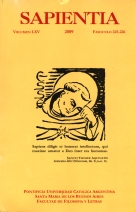¿Cómo razonar la fe desde sí misma?. Dos ejemplos medievales privilegiados
Keywords:
Anselmo, Santo, ob. de Canterbury, 1033-1109, EXISTENCIA DE DIOS, FILOSOFIA MEDIEVAL, LOGICA, LINGUISITCA, FEAbstract
Although with different ontologies, logics, and linguistic theories (particularly the suppositio) and radical differences regarding the problem of the universals, Anselm and Ockham are introduced as two Middle Age thinkers who use reason to support faith, and therefore coincide in the intuition of the common Fundament. The Anselmian argumentation makes use of the semantic supposition, logic consequence and material implication, to ‘think of the greatness of the greatest’ and send the spirit toward ‘the greatest’ that, by definition, aims farther; right to The One whom the heart already believes. Semantically, he uses the appelatio. So, he doesn’t confuse logics with ontology; or connotation with denotation, because it is a meta-linguistic reflection. He thinks through the contents of his faith, not of his statements. Thus, he takes care of the ‘beyond’ of ‘the greatest’ and not the comprehension of the word “God”. For Ockham, this comprehension doesn’t prove the predicate “existence”. By distinguishing between “demonstration” and “proof ”, he denies any demonstration of the existence of God. He takes into account the paths of movement, efficient causality and the end; which are irrelevant because they lack evidence and come from faith. He then turns to the proof of the personal linguistic supposition; because he doesn’t consider “God” as an intentional meta-linguistic sign. Ockham’s proof is armed by “the conservation of the authorities”, since conservation is not an infinite process; and everything that is conservable is, at the same time, conserved. Therefore, he condemns the existence of the Conservative but not of the Creator.
Downloads
Downloads
Published
How to Cite
Issue
Section
License
Copyright (c) 2009 Jorge F. Aguirre Sala

This work is licensed under a Creative Commons Attribution-NonCommercial-ShareAlike 4.0 International License.





 Sapientia
Sapientia